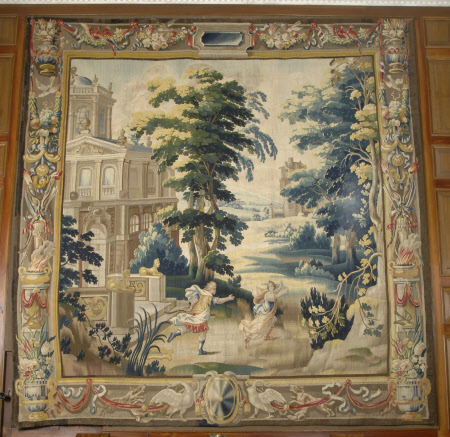Apollo and Daphne
probably English
Category
Tapestries
Date
circa 1680 - circa 1700
Materials
Tapestry, wool and silk, linen lining
Measurements
3.66 m (H); 3.20 m (W)
Place of origin
England
Order this imageCollection
Kingston Lacy Estate, Dorset
NT 1258065
Summary
Tapestry, wool and silk, 7 warps per cm, Apollo and Daphne, probably English, c. 1680-1700. In the foreground there are two small figures of Apollo, carrying a bow and arrows, chasing Daphne, who runs away with both arms outstretched, looking back fearfully over her shoulder. Apollo’s lyre lies on the ground behind him. The setting is a landscape with a palatial building on the left, trees on the right and a central vista to rolling hills and a castle. The side borders have vases of flowers, fires in urns and floral decoration, there are swags of flowers with parrots and a central cartouche in the upper border and dogs and geese either side of a silver shield in the lower border. The colours throughout are unusually fresh and bright.
Full description
The story of Apollo and Daphne is told in Ovid’s Metamorphoses. Thanks to an arrow from Cupid Apollo became infatuated with the nymph Daphne and pursued her. She fled through the forest, finally calling for aid from the river god Peneus, who transformed her into a laurel tree to save her from Apollo. The tapestry at Kingston Lacy is unusual in representing Daphne before her transformation. ‘Apollo and Daphne’ is part of a larger series of designs have with mythological scenes taken from both Ovid’s ‘Metamorphoses’ and his ‘Heroides’. As many as eleven different subjects have been identified belonging to this series, which may in fact be an amalgamation of two original series: one of with different stories from the ‘Metamorphoses’ – including the two subjects at Greyfriars - and another of the ‘Story of Sappho’ (Hefford 1983). As Koenraad Brosens has observed however, the practices adopted by many late seventeenth-century Flemish weavers, which involved circulating cartoons between different workshops, modifying cartoons by adding or removing figures, and continually amalgamating scenes from different series to customise suites, makes it difficult and often impossible to pinpoint the extent of such mythological tapestry sets (Brosens 2008, p. 203). The origin of the ‘Stories from Ovid’ has been the subject of protracted debate. In the early twentieth century Henry Marillier grouped together almost 100 tapestries with mythological subjects, small figures, and narrow borders like those seen at The Vyne. Since the majority of these tapestries were found in England Marillier speculated that they might be of English origin. Very few of these pieces had marks indicating their origin, and although Marillier found one piece with an English mark, another series at Boughton House had a monogram ‘MW’, which was unknown at the time (Marillier 1930). This monogram was subsequently proved to be that of the Antwerp tapissier Michiel Wauters (Crick-Kuntziger 1935), but Marillier continued to assert that the series was English, based on further examples that appeared on the art market with the English mark (Marillier 1940). Finally Wendy Hefford made an in-depth study of the surviving tapestries and of the documentation relating to the Wauters firm. Hefford concluded that the tapestries now known as ‘Stories from Ovid’ originated with the Wauters firm in Antwerp, whose records mention many of the surviving subjects, but that the designs were subsequently copied by English weavers. Most of the English versions were reversed in relation to the originals, and Hefford also established certain physical criteria for distinguishing between the Antwerp and English versions: in England the red dyes were of a finer quality, and the warp count slightly higher. Based on these criteria the tapestry at Kingston Lacy is likely to be English. None of the surviving records of the Wauters ‘Ovid’ tapestries mentions a designer for the set, however Hefford has attributed the design to the little-known Daniel Janssens (1636-1682). Originally from Mechelen (or Malines), a city which traditionally specialised in the production of designs for tapestry, he was registered as a master in the city’s painter’s guild in 1660 and later spent ten years in Antwerp, returning to his native town in around 1675. Janssens produced architectural and decorative works as well as tapestry designs, though little of the former survives. He worked extensively for the Wauters firm and is known to have designed many of their most popular tapestry series including the ‘Seven Liberal Arts’, examples of which survive in the National Trust’s collection at Cotehele (Hefford 1983; Brosens 2008, pp. 199-206) (no. 348261). There are tapestries from the ‘Stories from Ovid’ series, both English and Flemish weavings, in the National Trust’s collection at Cotehele (no. 348258), The Vyne (no. 719696) Lyme Park (no. 500317), Chirk Castle (no. 1171318) and Greyfriars (nos. 443635, 443645). (Helen Wyld, 2013)
Provenance
Bequeathed by (Henry John) Ralph Bankes (1902 – 1981) to the National Trust, together with the estates of Corfe Castle and Kingston Lacy and its entire contents in 1981
Makers and roles
probably English, workshop probably London, workshop Daniel Janssens (Mechelen 1636 - 1682), designer
References
Hefford, 2010: Wendy Hefford, ‘The English Tapestries’, in Guy Delmarcel, Nicole de Reyniès and Wendy Hefford, The Toms Collection Tapestries of the Sixteenth to Nineteenth Centuries, Zürich 2010, pp. 239-294 Brosens, 2008: Koenraad Brosens, European Tapestries in the Art Institute of Chicago, New Haven and London 2008 Hefford, 1983: Wendy Hefford, ‘The Chicago Pygmalion and the “English Metamorphoses”’, The Art Institute of Chicago: Museum Studies, 10 (1983), pp. 93-117 Marillier, 1940: Henry C Marillier, ‘The English Metamorphoses: a confirmation of origin’, Burlington Magazine, vol. 76, no. 443 (Feb. 1940), pp. 60-63 Crick-Kuntziger, 1935: Marthe Crick-Kuntziger, 'Contribution à l'histoire de la tapisserie anversoise: les marques et les tentures des Wauters', in Revue belge d'archéologie et d'histoire de l'art, 5, 1935, pp. 35-44 Marillier, 1930: Henry C Marillier, English Tapestries of the Eighteenth Century, London 1930
